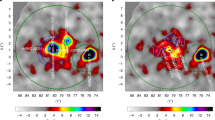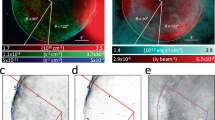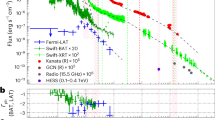Abstract
Galactic cosmic rays (CRs) are widely believed to be accelerated by shock waves associated with the expansion of supernova ejecta into the interstellar medium1. A key issue in this long-standing conjecture is a theoretical prediction that the interstellar magnetic field can be substantially amplified at the shock of a young supernova remnant (SNR) through magnetohydrodynamic waves generated by cosmic rays2,3. Here we report a discovery of the brightening and decay of X-ray hot spots in the shell of the SNR RX J1713.7-3946 on a one-year timescale. This rapid variability shows that the X-rays are produced by ultrarelativistic electrons through a synchrotron process and that electron acceleration does indeed take place in a strongly magnetized environment, indicating amplification of the magnetic field by a factor of more than 100. The X-ray variability also implies that we have witnessed the ongoing shock-acceleration of electrons in real time. Independently, broadband X-ray spectrometric measurements4 of RX J1713.7-3946 indicate that electron acceleration proceeds in the most effective (‘Bohm-diffusion’) regime. Taken together, these two results provide a strong argument for acceleration of protons and nuclei to energies of 1 PeV (1015 eV) and beyond in young supernova remnants.
This is a preview of subscription content, access via your institution
Access options
Subscribe to this journal
Receive 51 print issues and online access
$199.00 per year
only $3.90 per issue
Buy this article
- Purchase on Springer Link
- Instant access to full article PDF
Prices may be subject to local taxes which are calculated during checkout



Similar content being viewed by others
References
Hillas, A. M. Can diffusive shock acceleration in supernova remnants account for high-energy galactic cosmic rays? J. Phys. G 31, R95–R131 (2005)
Bell, A. R. & Lucek, S. G. Cosmic ray acceleration to very high energy through the non-linear amplification by cosmic rays of the seed magnetic field. Mon. Not. R. Astron. Soc. 321, 433–438 (2001)
Bell, A. R. Turbulent amplification of magnetic field and diffusive shock acceleration of cosmic rays. Mon. Not. R. Astron. Soc. 353, 550–558 (2004)
Takahashi, T . et al. Measuring the broad-band X-ray spectrum from 400 eV to 40 keV in the southwest part of the supernova remnant RX J1713.7-3946. Publ. Astron. Soc. Jpn (in the press); preprint at arXiv:0708.2002v1 [astro-ph]
Pfeffermann, E. & Aschenbach, B. in Röntgenstrahlung from the Universe (eds Zimmermann, H. U., Trümper, J. E. & Yorke, H.) 267–268 (Report No. 263, Max-Planck-Institut für extraterrestrische Physik, Garching, 1996)
Uchiyama, Y., Aharonian, F. A. & Takahashi, T. Fine-structure in the nonthermal X-ray emission of SNR RX J1713.7-3946. Astron. Astrophys. 400, 567–574 (2003)
Lazendic, J. S. et al. A high-resolution study of nonthermal radio and X-ray emission from supernova remnant G347.3-0.5. Astrophys. J. 602, 271–285 (2004)
Cassam-Chenaï, G. et al. XMM-Newton observations of the supernova remnant RX J1713.7-3946 and its central source. Astron. Astrophys. 427, 199–216 (2004)
Hiraga, J. S., Uchiyama, Y., Takahashi, T. & Aharonian, F. A. Spectral properties of nonthermal X-ray emission from the shell-type SNR RX J1713.7-3946 as revealed by XMM-Newton. Astron. Astrophys. 431, 953–961 (2005)
Reynolds, S. P. Models of synchrotron X-rays from shell supernova remnants. Astrophys. J. 493, 375–396 (1998)
Drury, L. O’C. et al. Test of galactic cosmic-ray source models—working group report. Space Sci. Rev. 99, 329–352 (2001)
Blandford, R. & Eichler, D. Particle acceleration at astrophysical shocks: a theory of cosmic ray origin. Phys. Rep. 154, 1–75 (1987)
Malkov, M. A. & Drury, L. O’C. Nonlinear theory of diffusive acceleration of particles by shock waves. Rep. Prog. Phys. 64, 429–481 (2001)
Zirakashvili, V. N. & Aharonian, F. Analytical solutions for energy spectra of electrons accelerated by nonrelativistic shock-waves in shell type supernova remnants. Astron. Astrophys. 456, 695–702 (2007)
Wang, Z. R., Qu, Q.-Y. & Chen, Y. Is RX J1713.7-3946 the remnant of the AD393 guest star? Astron. Astrophys. 318, L59–L61 (1997)
Koyama, K. et al. Discovery of non-thermal X-rays from the northwest shell of the new SNR RX J1713.7-3946: the second SN 1006? Publ. Astron. Soc. Jpn. 49, L7–L11 (1997)
Fukui, Y. et al. Discovery of interacting molecular gas toward the TeV gamma-ray peak of the SNR G347.3-0.5. Publ. Astron. Soc. Jpn. 55, L61–L64 (2003)
Jokipii, J. R. Rate of energy gain and maximum energy in diffusive shock acceleration. Astrophys. J. 313, 842–846 (1987)
Malkov, M. A. & Diamond, P. H. Nonlinear shock acceleration beyond the Bohm limit. Astrophys. J. 642, 244–259 (2006)
Lagage, P. O. & Cesarsky, C. J. The maximum energy of cosmic rays accelerated by supernova shocks. Astron. Astrophys. 125, 249–257 (1983)
Berezhko, E. G., Ksenofontov, L. T. & Völk, H. J. Confirmation of strong magnetic field amplification and nuclear cosmic ray acceleration in SN 1006. Astron. Astrophys. 412, L11–L14 (2003)
Vink, J. & Laming, J. M. On the magnetic fields and particle acceleration in Cassiopeia A. Astrophys. J. 584, 758–769 (2003)
Bamba, A. et al. Small-scale structure of the SN 1006 shock with Chandra observations. Astrophys. J. 589, 827–837 (2003)
Yamazaki, R., Yoshida, T., Terasawa, T., Bamba, A. & Koyama, K. Constraints on the diffusive shock acceleration from the nonthermal X-ray thin shells in SN 1006 NE rim. Astron. Astrophys. 416, 595–602 (2004)
Berezhko, E. G. & Völk, H. J. Theory of cosmic ray production in the supernova remnant RX J1713.7-3946. Astron. Astrophys. 451, 981–990 (2006)
Aharonian, F. A. et al. Primary particle acceleration above 100 TeV in the shell-type supernova remnant RX J1713.7-3946 with deep HESS observations. Astron. Astrophys. 464, 235–243 (2007)
Acknowledgements
This work is based on observations made with the Chandra X-ray Observatory, which is operated by the Smithsonian Astrophysical Observatory for and on behalf of NASA. This work also uses data obtained with the Suzaku X-ray satellite, which was developed at the Institute of Space and Astronautical Science of Japan Aerospace Exploration Agency (ISAS/JAXA) in collaboration with NASA, MIT and Japanese institutions.
Author Contributions Y.U. performed analysis of data obtained with the Chandra observations. F.A. investigated theoretical aspects of this work. Y.U. and F.A. jointly wrote the paper. T. Tanaka performed analysis of data obtained with the Suzaku observations. Y.M. checked the analysis of the Chandra data. T. Takahashi wrote a proposal requesting the Suzaku observations. All authors discussed the results and commented on the manuscript.
Author information
Authors and Affiliations
Corresponding author
Ethics declarations
Competing interests
The authors declare no competing financial interests.
Rights and permissions
About this article
Cite this article
Uchiyama, Y., Aharonian, F., Tanaka, T. et al. Extremely fast acceleration of cosmic rays in a supernova remnant. Nature 449, 576–578 (2007). https://doi.org/10.1038/nature06210
Received:
Accepted:
Published:
Issue Date:
DOI: https://doi.org/10.1038/nature06210
This article is cited by
-
Ultrafast visualization of an electric field under the Lorentz transformation
Nature Physics (2022)
-
Nonthermal electron acceleration at collisionless quasi-perpendicular shocks
Reviews of Modern Plasma Physics (2022)
-
Optical reconstruction of dust in the region of supernova remnant RX J1713.7−3946 from astrometric data
Nature Astronomy (2021)
-
PHEMTO: the polarimetric high energy modular telescope observatory
Experimental Astronomy (2021)
-
The interstellar medium in young supernova remnants: key to the production of cosmic X-rays and $\gamma $-rays
Astrophysics and Space Science (2021)
Comments
By submitting a comment you agree to abide by our Terms and Community Guidelines. If you find something abusive or that does not comply with our terms or guidelines please flag it as inappropriate.



